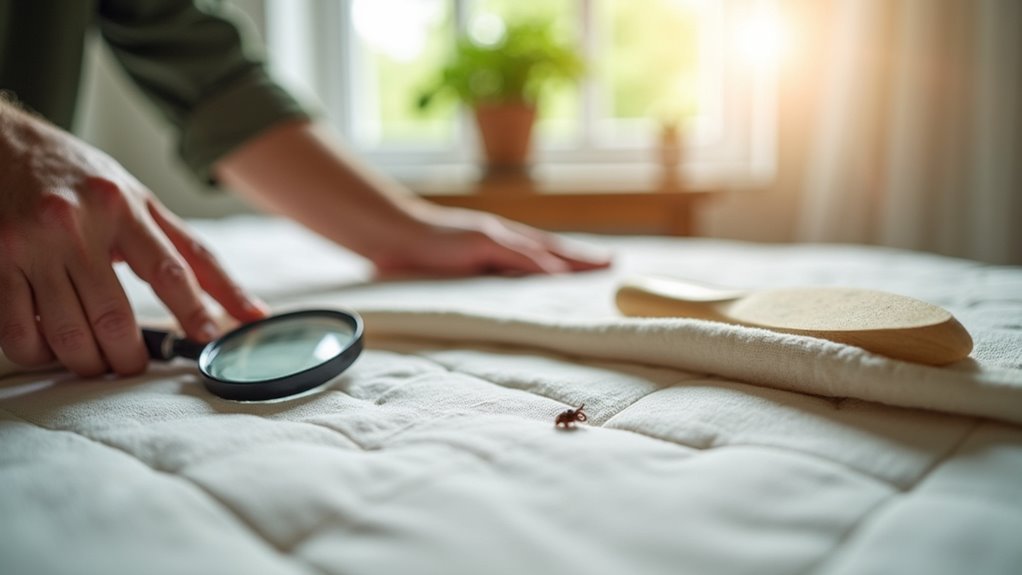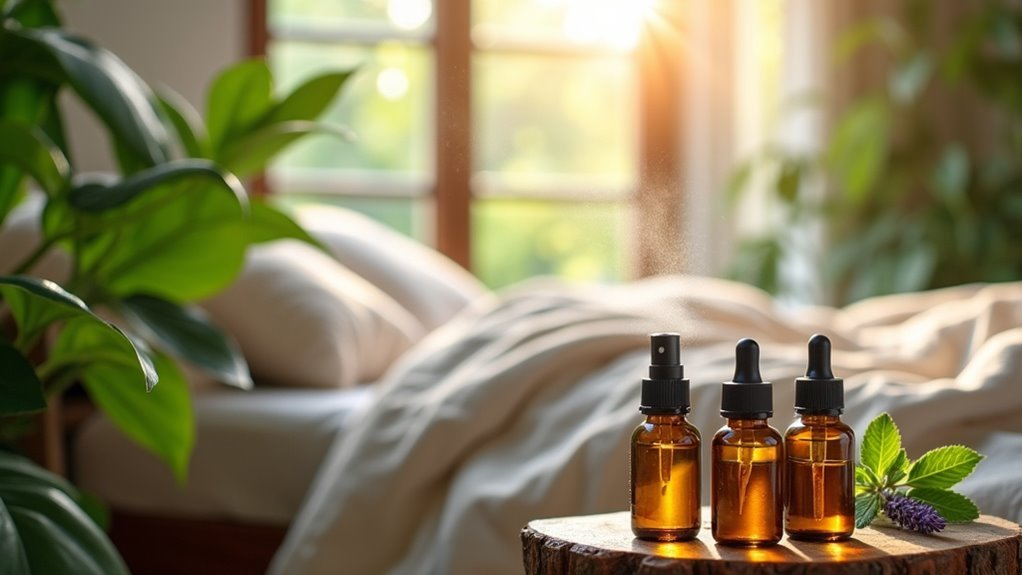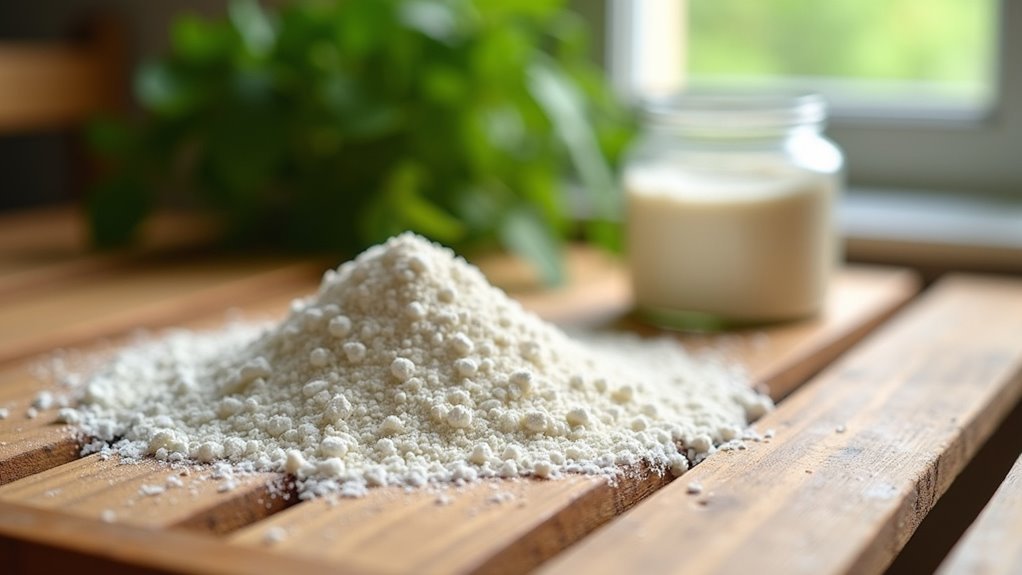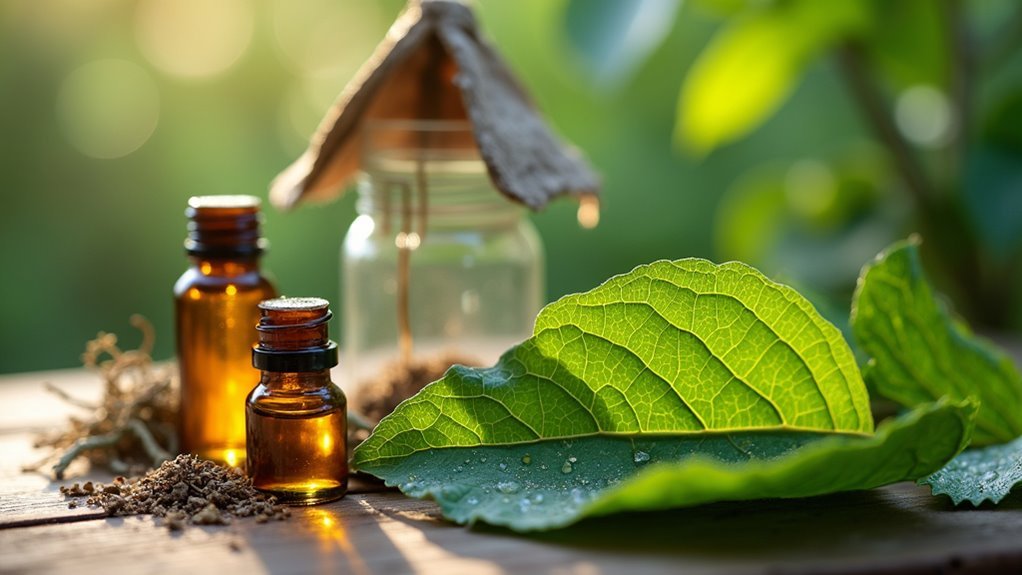You can prevent bed bugs naturally by conducting regular visual inspections of mattress seams and bed frames using bright lighting. Declutter your space consistently, removing piles of clothes and papers that create hiding spots. Apply essential oils like cedar, tea tree, or geranium around potential problem areas, and use food-grade diatomaceous earth in cracks and crevices. Wash linens in 130°F water, vacuum seal travel clothing, and create natural monitoring traps with essential oils to maintain a bug-free environment through thorough eco-friendly strategies.
Natural Inspection Techniques for Early Detection

While bed bugs are notoriously sneaky pests, you can catch them early through systematic visual inspections of your sleeping area. These natural inspection techniques don’t require chemicals or expensive equipment—just your eyes and good lighting.
Focus your search on mattress tufts, seams, and folds where bed bugs typically hide. Examine box springs and bed frames thoroughly, checking every crack and crevice. Look for telltale signs like black or brown spots of dried blood excrement, actual blood stains, and tiny eggs or eggshells.
Inspect mattress seams, bed frames, and box springs for dark spots, blood stains, eggs, and other bed bug evidence.
Use bright lighting during inspections, as bed bugs show up better against contrasting backgrounds. Trust your nose too—severe infestations often produce musty, sickly sweet odors.
Regular visual checks help you detect a bed bug infestation before it spreads throughout your home.
Eco-Friendly Decluttering for Bed Bug Prevention
Since bed bugs thrive in cluttered environments, maintaining an organized living space serves as your first line of defense against these persistent pests. You’ll eliminate countless hiding spots by regularly sorting through your belongings and disposing of unnecessary items. This proactive decluttering approach makes bed bug detection considerably easier during routine inspections.
Remove piles of clothes, newspapers, and magazines that create ideal breeding conditions. Store clean fabrics and clothing in sealed containers to prevent access and reduce reinfestation risks. Focus on sustainable decluttering by donating usable items rather than discarding them.
Establishing a consistent decluttering routine enhances your living quality while simplifying bed bug monitoring. You’ll spot early warning signs faster in organized spaces, enabling prompt intervention before infestations spread throughout your home.
Essential Oil Repellents That Actually Work

You’ll find that certain essential oils pack a real punch against bed bugs when you use them correctly.
Cedar oil stands out for its ability to suffocate these pests on contact, while geranium oil works best when you apply it to fabric surfaces and entry points around your bedroom.
Tea tree oil delivers maximum effectiveness at concentrations between 5-10%, giving you a potent natural weapon that won’t compromise your family’s health.
Cedar Oil Effectiveness
Although many essential oils claim to repel bed bugs, cedar oil stands out as one of the most scientifically backed options for natural pest control.
You’ll find that cedar oil’s natural compounds disrupt bed bugs’ navigation abilities, making it harder for them to locate you as their host. When these pests come into direct contact with cedar oil, it suffocates them while simultaneously preventing egg hatching.
Create your own cedar oil bed bug spray by mixing it with water and applying it to hiding spots like cracks, crevices, and furniture edges.
You’ll appreciate its pleasant scent compared to harsh synthetic pesticides. Best of all, cedar oil remains safe for your family and pets when used correctly, making it an ideal eco-friendly solution.
Geranium Application Methods
While cedar oil disrupts bed bugs’ navigation systems, geranium oil takes a different approach by targeting their sensory receptors through its high concentration of geraniol.
You’ll want to create an effective repellent by diluting several drops of geranium oil in water, then spraying this mixture around mattresses, box springs, and furniture crevices where bed bugs typically hide.
Enhance your cleaning routine by adding geranium oil to your regular cleaning solutions. This creates pest-repelling surfaces that bed bugs avoid while maintaining cleanliness.
The oil also masks the musty odor bed bugs produce, making treated areas less attractive to them.
For ongoing protection, place geranium oil-infused sachets in closets and drawers. This method provides continuous deterrent effects while adding pleasant fragrance to your storage spaces.
Tea Tree Concentrations
Because tea tree oil contains powerful insecticidal compounds, you need precise concentrations to maximize its effectiveness against bed bugs. A 5% concentration proves most effective, killing up to 90% of bed bugs within 24 hours.
You’ll want to dilute tea tree oil properly with carrier oils or water to prevent skin irritation while maintaining potency. For best results, mix one part tea tree oil with nineteen parts carrier solution.
This concentration balance guarantees both safety and effectiveness in your control methods. Apply this mixture directly to bed frames, mattress seams, and baseboards where bed bugs commonly hide.
The oil’s strong scent creates a natural barrier that repels remaining bugs. Regular reapplication every few days maintains protection and prevents future infestations in treated areas.
Diatomaceous Earth Application Methods

When targeting bed bugs with diatomaceous earth, you’ll need to apply this natural powder strategically to maximize its lethal effectiveness. Use a plastic bottle or duster to distribute DE evenly in thin layers throughout cracks, crevices, and hiding spots where bed bugs congregate.
Focus on bed frames, baseboards, and electrical outlets for ideal coverage.
Create protective barriers by sprinkling diatomaceous earth under mattress encasements and around your bed’s perimeter. This forces bed bugs to cross the powder, where microscopic sharp edges lacerate their exoskeletons, causing fatal dehydration.
Always choose food-grade DE for safety around humans and pets.
Reapply the powder after changing sheets or cleaning to maintain continuous protection against infestations.
Heat Treatment Solutions Using Household Items
Beyond powder applications, heat offers another powerful weapon in your green bed bug prevention arsenal.
You can achieve effective heat treatment using common household items without harsh chemicals. Steam cleaners work excellently for targeting mattress seams, furniture cracks, and baseboards where bed bugs hide. Simply apply steam to reach the required 120°F for 90 minutes to eliminate all life stages.
Your washing machine becomes a control tool when you wash linens and clothing in 130°F water, then dry on high heat for 30 minutes.
For non-washable items like stuffed animals or shoes, run them through your dryer’s high heat cycle.
Regular vacuuming helps remove bugs while generating heat that aids elimination—just seal vacuum bags immediately after use.
Organic Mattress and Pillow Protection Strategies
You’ll want to focus on two key areas when protecting your mattress and pillows from bed bugs organically.
First, invest in high-quality, breathable encasements made from tightly woven organic materials that create an impenetrable barrier around your bedding.
Second, establish consistent organic cleaning routines using natural products and hot water treatments that eliminate pests without introducing harmful chemicals into your sleep environment.
Natural Encasement Solutions
As organic mattress and pillow encasements create an impenetrable barrier against bed bugs, you’re investing in one of the most effective green prevention strategies available.
These natural encasement solutions protect your organic mattress and pillows while maintaining a non-toxic sleeping environment for your family and pets.
When selecting encasements, focus on these essential features:
- High-grade zippers with secure flap seals that prevent bed bug entry and escape
- Durable organic materials that withstand regular washing and maintain barrier integrity
- Allergen-blocking properties that reduce dust mites and improve air quality
- Easy maintenance design for simplified cleaning and reinfestation prevention
You’ll need to inspect your encasements regularly for wear or damage.
Proper maintenance guarantees continued protection while simplifying your cleaning routine and minimizing reinfestation risks throughout your home.
Organic Cleaning Methods
Maintaining your organic mattress and pillow protection requires consistent cleaning methods that eliminate bed bugs without compromising your health or environmental values.
Organic cleaning methods focus on enzyme-based cleaners that break down bed bug proteins and eliminate infestations naturally. You’ll want to treat all surfaces and fabrics with these natural cleaning products, which work effectively without introducing toxic chemicals into your sleeping environment.
Apply organic insect repellents containing peppermint or tea tree oil around your bed area as a gentle deterrent. These natural oils create an unwelcoming environment for bed bugs while maintaining air quality.
Establish a weekly rotation schedule for cleaning all bedding materials at temperatures above 120°F. This heat treatment kills bed bugs and eggs while preserving your organic encasements’ integrity and ensuring long-term protection.
Green Cleaning Products for Bed Bug Control
When you’re facing a bed bug infestation, green cleaning products offer powerful solutions that protect your family’s health while effectively eliminating these persistent pests.
Several eco-friendly options deliver impressive results without toxic chemicals:
- Kleen Green – Uses enzymes to force premature molting in insects, eliminating bed bugs without dangerous fumes.
- Food grade Diatomaceous Earth – Damages bed bugs’ exoskeletons on contact, causing fatal dehydration through natural abrasion.
- Ecoraider – Cedar and geranium-based spray that kills bed bugs at rates matching chemical pesticides while remaining pet-safe.
- Hygea Natural – Provides immediate contact kills and won’t harm children or animals during application.
You can also enhance your prevention strategy by using natural cleaning solutions like vinegar and baking soda to disrupt bed bug habitats and eliminate hiding spots throughout your home.
Natural Sealing Techniques for Cracks and Crevices
While green cleaning products eliminate existing bed bugs, preventing future infestations requires you to seal the tiny hiding spots where these pests establish new colonies.
Focus your efforts on visible cracks and crevices throughout your home, particularly around baseboards, walls, and plumbing connections. Apply silicone sealant or caulking to these vulnerable areas to create effective barriers against bed bug migration between rooms.
Seal cracks around baseboards, walls, and plumbing with silicone caulking to prevent bed bugs from spreading between rooms.
Pay special attention to heating pipes and plumbing connections, as these represent common entry points. Seal gaps under sinks and around door frames using appropriate materials.
Install weather stripping on doors and windows for thorough pest control while improving energy efficiency. Establish routine inspections to guarantee sealed areas remain intact and wear-free, maintaining your home’s natural defenses against infestations.
Eco-Safe Travel Prevention Practices
Beyond protecting your home environment, you’ll need to maintain vigilance when traveling to prevent bringing bed bugs back with you.
These eco-safe travel prevention practices will help you avoid unwanted hitchhikers without relying on harsh chemicals.
When you arrive at your accommodation, implement these green strategies:
- Store luggage in the bathtub while inspecting your room thoroughly for bed bug signs
- Vacuum seal your clothing to create an impenetrable barrier that prevents bed bugs from clinging to fabrics
- Apply natural essential oil repellents to your luggage and garments as a chemical-free deterrent
- Examine luggage seams and folds regularly throughout your trip, especially in interconnected lodgings where bed bugs spread easily
These environmentally conscious methods protect both you and the planet.
Plant-Based Monitoring and Trap Systems
You can create effective bed bug monitoring systems using natural materials that won’t harm your family or pets.
Essential oils like peppermint and neem work as powerful deterrents while adding pleasant scents to your home.
These botanical detection methods help you spot infestations early and take action before problems escalate.
Natural Trap Construction
Since bed bugs follow predictable travel patterns between their hiding spots and your sleeping area, you can intercept them using strategically constructed plant-based traps.
These natural traps offer an eco-friendly monitoring solution that doesn’t rely on harsh chemicals.
You can create effective bed bug monitoring systems using simple materials:
- Cardboard or wood bases – Cut into small squares and place near bed legs or along baseboards where bed bugs commonly travel
- Essential oil enhancement – Spray diluted lavender or tea tree oil on trap surfaces to increase attractiveness while deterring future infestations
- Sticky corn syrup mixture – Combine corn syrup with soap to create a capture surface that traps bed bugs on contact
- Regular maintenance schedule – Replace traps weekly to maintain monitoring effectiveness
Position these natural traps strategically for ideal interception and early detection.
Essential Oil Deterrents
While synthetic pesticides dominate commercial bed bug control, essential oils provide a powerful plant-based alternative that disrupts these pests’ sensory navigation systems.
You’ll find peppermint, lavender, and tea tree oil particularly effective as essential oil deterrents due to their potent scents that repel bed bugs naturally.
Create diluted spray solutions for easy application around areas where bugs hide, including baseboards, mattresses, and furniture seams.
You can enhance your monitoring by placing cotton balls soaked in essential oils throughout your home to detect activity patterns.
Integrate these oils into your cleaning routine by adding drops to laundry or vacuum bags.
For trapping, combine essential oils with vinegar or soapy water to capture bed bugs attracted to the scents while immobilizing them in the solution.
Botanical Detection Methods
Beyond deterrence, strategic plant-based monitoring transforms your home into an early warning system that detects bed bug activity before infestations become overwhelming.
Botanical detection methods offer non-toxic alternatives to chemical monitoring systems while maintaining effectiveness.
You can implement these plant-based strategies:
- Strategic trap placement – Position plant-based lure systems near beds, furniture seams, and potential hiding spots to capture bed bugs for monitoring.
- Essential oil monitoring – Use tea tree or neem oil in trap systems as both attractants and natural insecticides.
- Scent-based detection – Deploy lavender and mint plants around living spaces to create natural barriers while monitoring for activity.
- Eco-friendly surveillance – Combine botanical detection methods with visual inspections for thorough, chemical-free bed bug monitoring.
This approach creates a greener home environment while providing early infestation alerts.
Frequently Asked Questions
Can I Sleep With Diatomaceous Earth on My Bed?
You can sleep with food-grade diatomaceous earth on your bed, but it’s better to apply it under mattress encasements or around bed frames to minimize skin contact while maintaining effectiveness.
How Long Does It Take to Get Rid of Bed Bugs With Diatomaceous Earth?
You’ll need several days to weeks with diatomaceous earth to eliminate bed bugs completely. The timeline depends on your infestation’s severity and how thoroughly you’ve applied the powder in hiding spots.
Where to Put Diatomaceous Earth for Bed Bugs?
You’ll want to apply diatomaceous earth around baseboards, bed frames, under mattresses, in cracks and crevices, behind outlets, inside drawers, and around your bed’s perimeter to target bed bugs effectively.
What Kills Bedbugs Permanently?
You’ll permanently kill bedbugs using heat treatments above 120°F, diatomaceous earth that dehydrates them, enzyme-based products disrupting their life cycle, high-temperature laundering over 130°F, and non-toxic contact sprays.
In Summary
You’ve now got a complete toolkit of earth-friendly strategies to keep bed bugs away without harmful chemicals. Start implementing these natural methods today—inspect regularly, declutter your space, and use essential oils as deterrents. Remember, prevention’s always easier than elimination, so don’t wait until you’ve got an infestation. Stay vigilant during travel, seal entry points, and maintain your green cleaning routine. Your home’ll stay bed bug-free naturally.





Leave a Reply